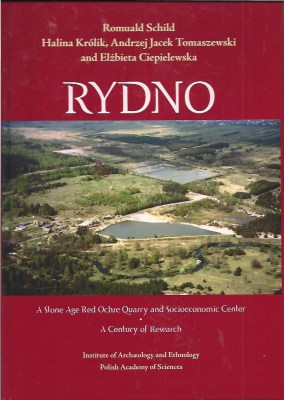 RYDNO
RYDNO
Rydno
Informacje bibliograficzne
Tytuł: Rydno. A Stone Age Red Ochre Quarry and Socioeconomic Center. A Century of Research
Autor: Romuald Schild, Halina Królik, Andrzej Jacek Tomaszewski, Elżbieta Ciepielewska. With Contributions by Jan Fiedorczuk and Zdzisław Hensel
Wydawca: Instytut Archeologii i Etnologii PAN
Miejsce: Warszawa
Rok wydania: 2011
Język: angielski
Liczba stron: 468
Format: A4
Okładka: twarda
ISBN: 978-83-89499-90-5
Opis
Since the advent of anthropological investigation, it has been evident that red ochre had many important uses during prehistoric times. Red Ochre was certainly the most important commodity in the Stone Age. In the recent world of small societies, as in prehistory, sources of red ochre are less prevalent than those of siliceous materials are. Therefore, their value and social significance outweighed that of flint. This can be seen in the enormous Rydno agglomeration of settlements that have no parallel in the Stone Age camps that rarely accompany flint quarries
Overall campsite density in the Rydno Complex is on a scale unmatched by any other areas of prehistoric settlement in the world. By way of barter, but also by traveling to the quarry area, the Final Paleolithic and Mesolithic world of Central and Northern Europe procured and distributed the red ochre hematite gravel and clay. The Rydno Center emerged as a place where human groups either extracted the hematite and clay by themselves or procured it from other groups controlling the source. Many of the groups camped in the area longer than the necessary time for the acquisition of the desired product, often combining red ochre procurement with intensive processing of flint brought in from the neighboring chocolate flint quarries. Organized and probably long-lived villages at Rydno are one of the factors implying that at certain times social groups composed of several households controlled the quarry and received compensation for a permit to access the mine. At other times, right of entry to the complex may have been relatively easy. Intense occupation of the Rydno area, the presence of a large array of raw materials, including exotic ones, in the remains of the camps, as well as the discrete sociotopographic locations of different social and/or ethnic groups, give rise to the proposition that Rydno was also an important meeting ground for hunter-gatherer bands, temporarily aggregating for joint social ceremonies and trade.
Even to a non-specialist in prehistoric archaeology, a very close analogy between Australia's Parachilna, as well as other similar recent ochre sites of Australia or the Americas, and Rydno is evident. These similarities are governed by the universal socioeconomic rules of hunter-gatherer and forager societies resulting from their place in the ecological and social environment. The Rydno of our forefathers, with its changing histories of ownership and systems of access to the quarry, meeting grounds, places of group aggregation and distant expeditions is an ancient telescopic synthesis of nearly all recent red ochre sites and their socioeconomic environments.
Spis treści
Preface
Acknowledgements
1. Introduction
2. A Brief History
Ludwik and Irena Sawicki
Stefan Krukowski
The Salvage Excavations
3. Geomorphology
Introduction
Stratigraphic Setting of the Sites
Age of the IIId Kamienna Terrace
4. Czerwienica (Red Place), the Rydno Quarry (by Romuald Schild and Halina Królik)
Introduction
Stratigraphy
Elements of the Mine
5. Elements of the Topographic Differentiation of Campsites
Introduction
Rydno Quarry's Environs: The Red-colored Area and Nad Niwką (At the Little Field)
The Terrace Edge Nad Piaską (On the Piaska Brook) or Nad Mostowiną (At the Footbridge) and Na Osach (At the Aspen Woods)
Pastwisko (The Pasture)
Przy Torze (Near the Railway Track)
U Wygonu (At the Common Pastureland)
Sandro (the Outwash Fan)
The Sahara
Za Rzeką (Across the River)
Michałów-Piaska
6. Elements of Raw Material Economy Differentiation
Introduction
Raw Materiał Structure of Rydno Assemblages
7. Approaches to the Taxonomy of Flint Assemblages
TheMethod of Presentation, Typology, and Technological Structure of Inventories
Raw Materials
Caches of Precores and Cores
8. Non-Siliceous Materials of Rydno
9. Radiocarbon Assays
10. Settling of Rydno
The Mystery of the Oldest Visitors to the Rydno Quarry
Late Magdalenian Assemblages with Arch Backed Pieces
The Arch Backed Piece Technocomplex, Last Interstadial Controllers of Rydno
Tanged Point Technocomplex
Early Mesolithic, the Narvian
The Desnan
Late Mesolithic, the Vistulian
The Neolithic and Later Periods
11. Rydno, a Prehistoric Ochre Site and Social Aggregation Center, or a Frame of Reference of Two Behaviorists. A Synthesis (by RomuaId Schild and Halina Królik)
Various Uses of Red Ochre
The Arch Backed Piece Technocomplex and Socioeconomic Organization of Life in Rydno
The Masovian and Socioeconomic Organization of Life in Rydno
The Sociotopographic Setting of the Rydno Settlement through Time
Does Rydno Mirror the Red Ochre Mines and Centers of the Recent Past?
Appendix
Physical and Chemical Examination of Hematite Gravel from Rydno Quarry and the Final Paleolithic Campsites of Całowanie (by Zdzisław Hensel)
References
The Catalog of Archaeological Sites of the Rydno Complex Collected and Excavated around 1910, and in the 1923-2004 Field Seasons
Index

